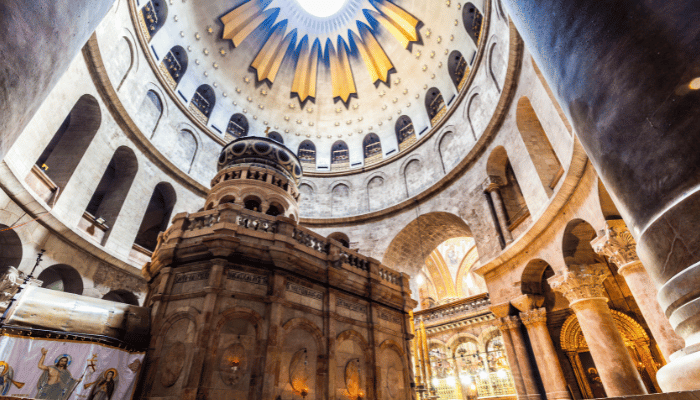Church of the Holy Sepulchre Tours

[ez-toc]
A Journey Through History and Faith: Entering the Church of the Holy Sepulchre
Jerusalem, a city etched in history and layered with religious significance, holds few places as sacred as the Church of the Holy Sepulchre. Believed to encompass the sites of Jesus' crucifixion and resurrection, the church has beckoned pilgrims for centuries, drawing them into a space where reverence hangs thick in the air. Stepping through its ancient doors is not merely entering a building; it's embarking on a journey through time, faith, and the complexities of religious coexistence.
The church, a complex of chapels and shrines administered by six different Christian denominations, presents a visual feast. Its imposing facade, weathered by time, conceals a labyrinthine interior adorned with mosaics, intricate carvings, and flickering candlelight. Sunlight streams through stained-glass windows, casting colorful hues on worn stone floors and the faces of pilgrims lost in silent prayer.
The scent of incense mingles with the musty aroma of centuries, creating a unique olfactory signature. Languages intermingle – prayers whispered in Latin, hymns sung in Greek, and conversations carried in a multitude of tongues. The atmosphere pulsates with a potent mix of emotions – awe, solemnity, and quiet hope.
Following the Stations of the Cross, etched into the worn stones, you ascend Golgotha, the hill where Jesus is believed to have been crucified. Here, amidst the hushed reverence, you stand where history unfolded, contemplating the weight of sacrifice and redemption.
From there, the path leads to the holiest site within the church – the Holy Sepulchre itself. Enclosed within a marble structure called the Aedicule, the tomb hewn from rock resonates with its quiet power. A palpable hush descends as pilgrims take turns kneeling and venerating the site, their expressions etched with a complex mix of faith and personal reflection.

Beyond the Aedicule lie chapels belonging to different denominations, each reflecting its own artistic style and unique traditions. The Ethiopian chapel thrums with a vibrant energy, filled with rhythmic chanting and colorful prayer shawls. The Armenian chapel, adorned with ornate chandeliers and paintings, offers a glimpse into their distinctive artistic heritage. This tapestry of traditions speaks volumes about the diverse strands of Christianity that converge within the church walls.
Yet, amidst the grandeur and devotion, the complexities of the shared space become apparent. Ownership disputes and territorial markings within the church are stark reminders of the historical tensions that have long simmered. Signs in various languages delineate areas, and occasional whispers of disagreement hint at the delicate balance maintained between the denominations.
Despite these challenges, the enduring significance of the church transcends temporal squabbles. Stepping outside, pilgrims emerge carrying a piece of Jerusalem with them – a sense of the city's ancient spirit, the weight of its history, and the enduring power of faith that continues to draw millions to its sacred spaces.
The Church of the Holy Sepulchre is more than just a historical landmark; it's a living testament to the enduring power of belief. It's a crucible where history, faith, and human stories interweave, creating a tapestry of profound significance that continues to resonate across generations and cultures. Whether one views it with religious devotion or historical curiosity, it remains a powerful space that challenges visitors to contemplate the legacy of Jesus and the complex tapestry of faith that continues to shape the world around us.
Was Jesus buried in the Holy Sepulchre?
Whether Jesus was buried in the Holy Sepulchre is a complex question with no definitive answer. Here's what we know:
Arguments for the Holy Sepulchre:
- Tradition: Since the 4th century, the site has been revered as the location of Jesus's crucifixion and burial. This long-standing tradition holds significant weight for many Christians.
- Archaeological evidence: There is some physical evidence supporting the site's authenticity, such as its location outside the city walls at the time of Jesus and the presence of an ancient tomb within the church.
- Continued significance: The Holy Sepulchre remains a crucial pilgrimage site for Christians worldwide, holding immense religious and historical importance.
Arguments against the Holy Sepulchre:
- Lack of conclusive proof: Archaeological evidence cannot definitively prove who was buried in the tomb or that it served as Jesus's specific burial site.
- Historical gap: There's a 300-year gap between Jesus's death and the identification of the site, leaving room for uncertainty.
- Alternative locations: Other potential burial sites have been proposed, some even within Jerusalem itself.
Overall:
The question of Jesus's burial location remains a matter of faith and historical investigation. The Holy Sepulchre holds deep significance for many Christians, but conclusive proof of its authenticity is lacking. Ultimately, individual beliefs and interpretations of evidence shape how people answer this question.
It's important to consider both sides of the issue and respect diverse perspectives when exploring this topic. If you'd like to delve deeper, I can offer resources on the various arguments and historical discussions surrounding the Holy Sepulchre.
FAQ
[sp_easyaccordion id="583"]
More Places in Gray Line: Tours in Petra | Israel Tour Package | Tours in Amman











